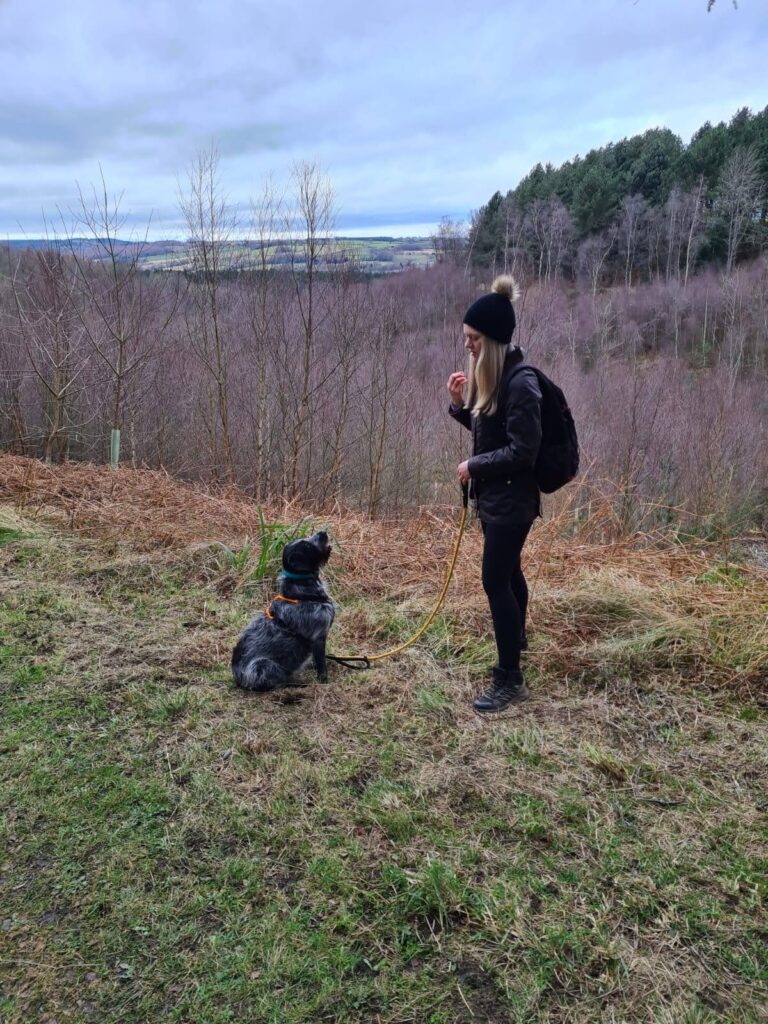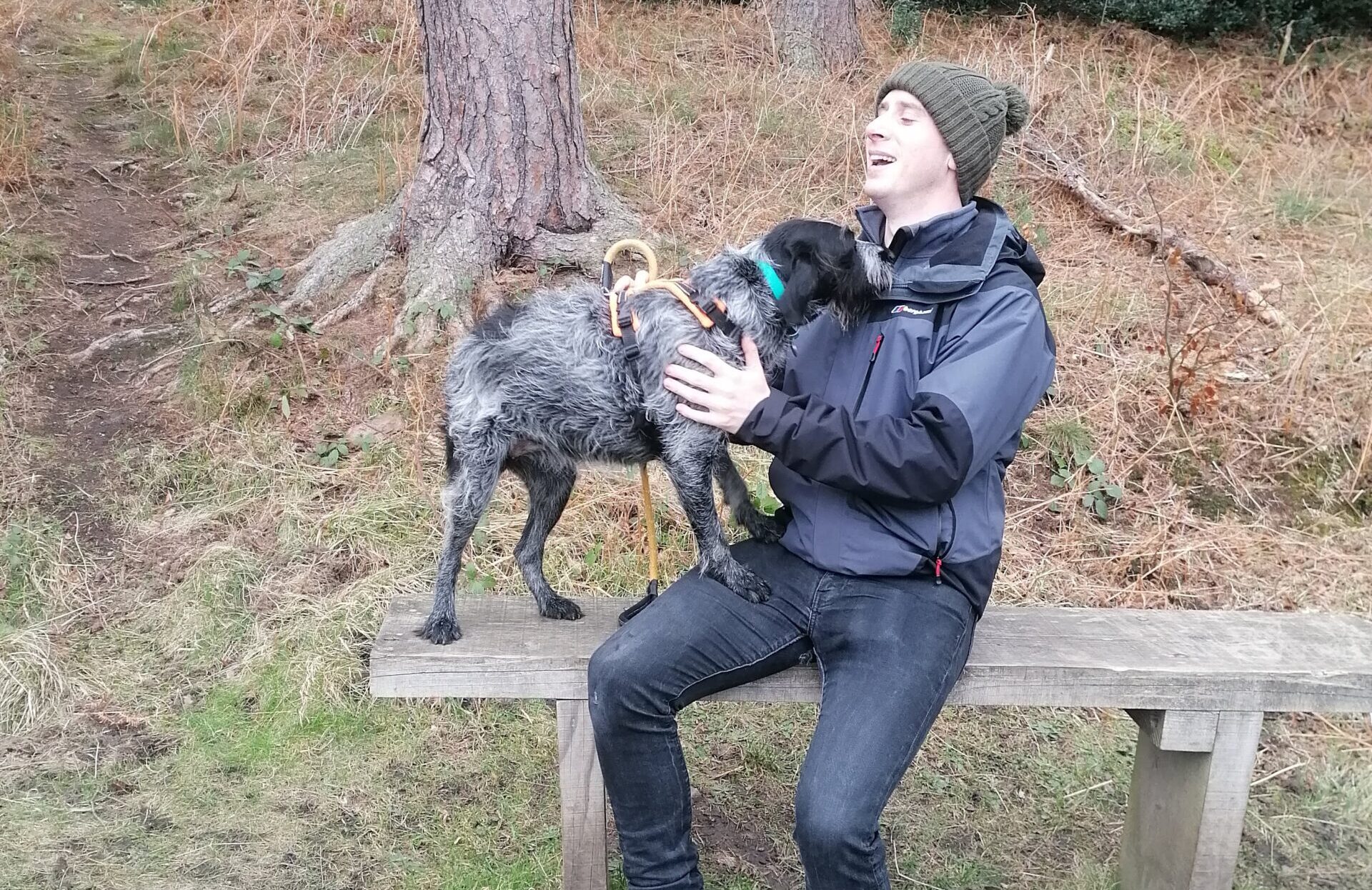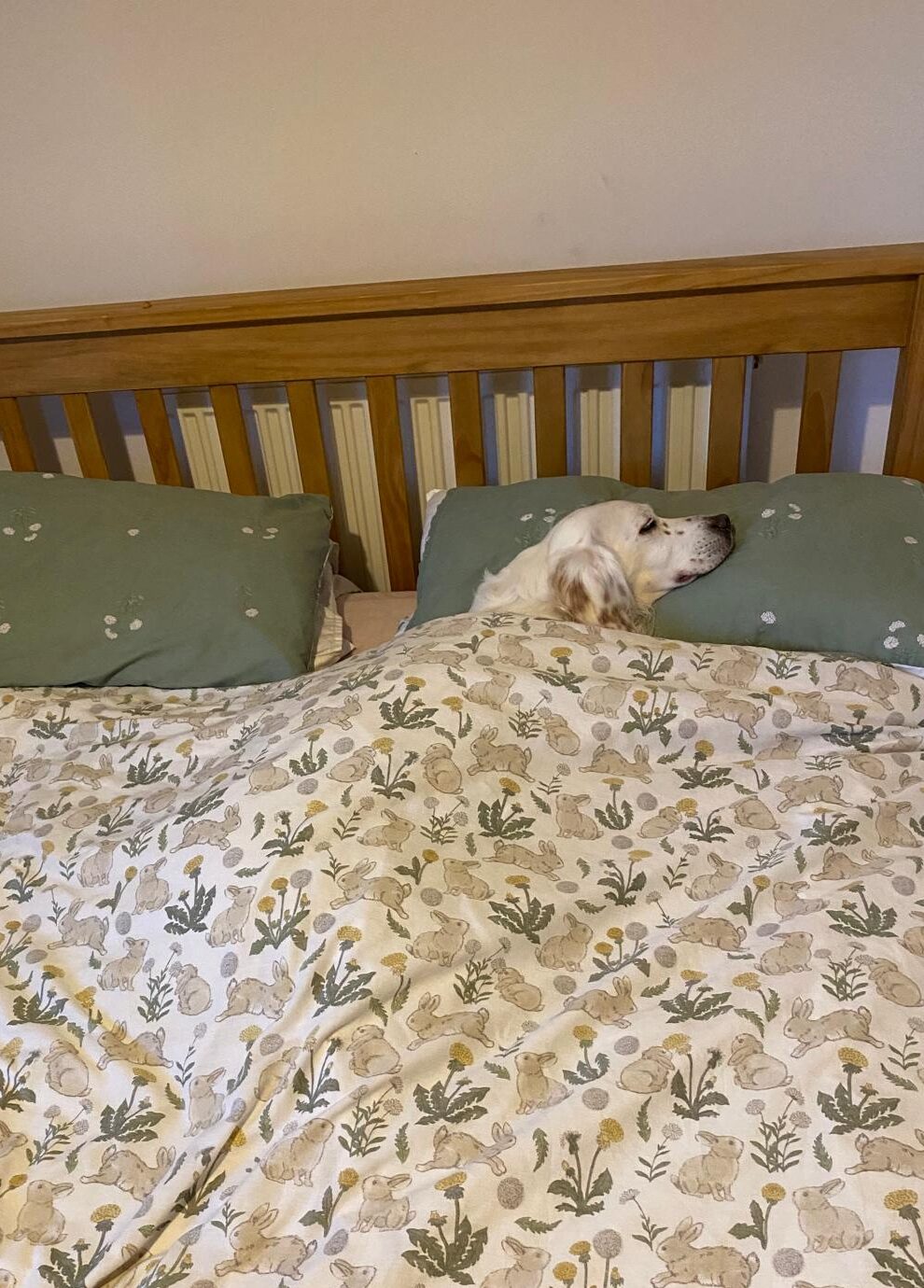Many of the dogs we rehome will have issues with recall, and to keep them safe, they’ll have many walks where they will be on a lead.
Most of us won’t have to travel too far to get to an area that offers a wonderful walk with beautiful scenery. However, you should keep in mind that just because we may find a walk through the woods or countryside a peaceful and calming experience, for our dogs that environment can be the total opposite.
This does not mean your dog hates that idyllic walk in the wood you’ve taken them on – far from it!
What it does mean is that some walks provide your dog with such a stimulating environment, that some can just become overwhelmed. A pretty woodland setting to us humans, is absolutely overflowing with sights, sounds and smells for your dog. They are taking in far more sensory wise on that walk than us humans are.
Does that mean we just avoid these walks? No, of course not. They will love those walks.
It means we need to be mindful of our dogs on walks, manage our expectations of them accordingly and manage their spoons!
A new dog who has recently arrived at your home, will already be adjusting to a whole new world, they’ll be low on spoons, and will become very overwhelmed, very easily, especially on an exciting walk.
We constantly chant our mantra of ‘Keep your dog’s world small’ when they first arrive, and we will always advocate for letting your dog gather spoons. This is also the case for a dog who may have been poorly or is experiencing a stressful life event like a new baby arriving on the scene or a house move.
Part of this small world approach has to be managing your dog’s walks.
The outdated advice of ‘take your dog out for a nice long walk – it’ll help them settle’ needs to be kept in the past. Taking your dog out on a long, exciting walk will not help them gather spoons or calm them. Many dogs will love these walks – when they have the spoons to enjoy it! This outdated claim fails to account for the fact that no two dogs are the same, and we need to adapt to them as individuals.
Some dogs will naturally have more spoons than others and will be able to cope better with change and the excitement and stimulation new walks will bring. But for those dogs who have fewer spoons or are newly settling in, or recovering from a life change or illness, a slower steadier approach is the best one.
Rest days
News flash – we ALL can benefit from a rest day, even our dogs.
There is nothing wrong at all with having a rest day and not doing any walks or keeping walks short and ‘boring’ for a few days if they need it. Slow it down and respond to your dog’s needs!
If your dog is anxious, stressed or seems overly excited on walks, take a step back and let them relax. Trust us there are plenty of enrichment activities you can do at home and in the garden to keep them mentally stimulated if they are on a rest day from walks that will keep them entertained.
Overstimulated on walks
Many of the dogs we rescue are ex-working dogs that have impressive predatory senses and high prey drive. When you’re first taking them on a walk in your local woodland, just think there is a LOT going on for them to contend with. So many scents of wildlife and other dogs, so much prey – birds, rabbis, squirrels, etc, probably lots of noises – other people, rustling of trees, wildlife.
For many dogs, taking them for a walk in the woods and trying to get their attention is the equivalent of standing a child next to the world’s biggest chocolate fountain and expecting them to ignore that and have their full attention on you… it isn’t happening!
These kinds of environments, such as the woods, countryside walks, we often refer to as ‘highly stimulating’. There is a lot for your dog to take in and it can easily become overwhelming. If you’re finding your dog is becoming overwhelmed on these type of walks, scale it back and opt for less stimulating walks, for example, the local park, a pavement walk, or for some dogs the beach is such a walk – not because they don’t love it but there are typically fewer distractions and stimulus to contend with.
One major sign that your dog is too stimulated on a walk is their utter refusal to take any notice of you whatsoever. If you’re dangling a delicious treat in front of your dog’s face and they refuse to acknowledge it at all, it means one of two things:
The treat wasn’t high value enough, or
Their attention is captured by the overly stimulating environment around them.
Most of us have been there – you’re out on a walk and desperately pleading to get your dog to focus on you rather than that pigeon on the other side of the track, but they’re having none of it. So, what do you do?
There is no ‘quick fix’ for this, but if you are persistent and consistent, you can train your dog to focus on you even in stimulating environments. This will also mean in time that those walks in the woods can be enjoyed by both you and your dog without either of you getting stressed, anxious or overwhelmed.
Training
Training starts in the home. Some people will talk about the three D’s when training – Distance, duration and distraction.
Distraction – you want as few distractions as possible when trying to teach them something new
Duration – you will only be able to hold their attention or gain their true focus for short spells at first
Distance – to maintain their attention you will start with them near to you when training a command.
Now as they progress you can increase the number of distractions, along with the duration and distance between you and your dog.
Exercises
‘Watch me’
One of the key things you can do when your dog is out on a walk and pulling like a lunatic because they’ve seen a squirrel or whatever they’re interested in, and you want their attention on you, is the ability to make eye contact with your dog. Once you get eye contact with your dog, it breaks their focus and acts as a reset which can really help calm them down. You want their attention to be on you and not everything else around them.
A key command I use with my dog to get her attention on a walk or when she’s focused on ‘prey’ is the ‘watch me’ command. You could call this ‘look’ or ‘here’ or whatever you want but keep the term you use consistent!
So to teach this (remember we are starting to teach this at home, considering the three D’s, before progressing to doing this on walks)…
Take a high value treat in your hand and have your dog close to you so they can see the treat
Bring the treat up to your eye level and hold it next to your eyes
Wait there until your dog looks up and glances at you/the treat
When they do give them lots of praise and give them the treat
Then start to do this and as you lift your hand up to your eyes use your verbal command ‘Watch me’
Each time they do it, lots of praise and give them the treat.
As they improve increase the D’s – distractions, distance and duration.
Check in
Having your dog ‘check in’ on you while out on walks is a great way to assist in training their recall and again get their focus back on you and not their environment.
Tips to train…
Take your dog to an empty secure field/garden and if in a public/unsecured area attach a long line
Completely ignore your dog and wait for them to give you attention (word of warning – you may have a long wait)
As soon as your dog checks in on you/ looks at you – praise them! Instigate play/lots of cuddles/give them a treat. Let them know that giving you attention is the best thing ever!
Practice, practice, practice.
Over time your dog will learn that focusing on you is far more rewarding than looking off somewhere else and wandering off in search of that pigeon.
‘Leave’
Our dogs have high prey drives, and part of this is what makes walks in interesting places a whole lot more exciting. In the event they do start to pursue prey or chase a cat, etc, having the ‘leave’ command down to a T is invaluable.
To teach…
Start with food – put a treat on the floor in front of your dog and tell them to ‘leave’ (if they won’t at first, cover it with your foot if needs be)
When they do leave the treat or if they look away from it, give them lots of praise and then give them a different treat from your hand to reward
You can even designate other household animals as “leave” and once your dog has mastered the command, they should completely leave their brothers and sisters alone.
Other tips
Small world – start with small ‘boring’ walks and build up gradually. What may be a boring walk for you will still provide a lot of stimulation for your dog.
Rest and recover – if your dog has had a very stimulating day give them plenty of opportunity to recover their spoons. If they need a rest day, don’t be afraid to take one.
Harnesses – we always advise every dog is walked on a properly fitting harness (ADD link when sorted). Many of the harnesses we recommend have a front clip attachment which can be invaluable if your dog is overly stimulated on a walk and you need greater control of them to stop any pulling.
It is your dog’s walk! This doesn’t mean we advocate letting them pull you over miles of countryside on the pursuit of a rogue bird… but it does mean letting your dog safely explore on their walk. If your dog wants to stop and sniff and investigate, let them (provided it’s safe for them to do so). And if your dog is indicating they’re nervous to walk a certain way or they’re too tired to continue, don’t force them. Respect what they’re trying to communicate to you.





